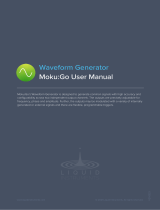
11 | Moku:Go’s Arbitrary Waveform Generator User Manual © 2021 Liquid Instruments. All rights reserved.
Custom
Uploading custom waveforms
• Upload custom waveforms from comma- or newline-delimited text from a computer file or
clipboard.
• Up to 8,192 points can be output at an update rate of 125 MSa/s, up to 16,384 points at 62.5
MSa/s, up to 32768 points at 31.25 MSa/s and up to 65,536 points at 15.625 MS/s
Maximum recommended sampling rate
• The maximum safe frequency of the generated waveform is equal to the sampling rate
divided by the number of points in the custom waveform .
o For example, the maximum safe frequency of a 1000-point waveform is 125 MSa/s ÷
1000 Samples = 125 kHz .
• Exceeding the maximum recommended frequency will result in some points being skipped.
Amplitude scaling and interpolation
• The amplitude of custom waveforms will be normalized to the range [-1, +1] and then scaled
to the desired amplitude and offset.
• Select between linear and no interpolation.
















